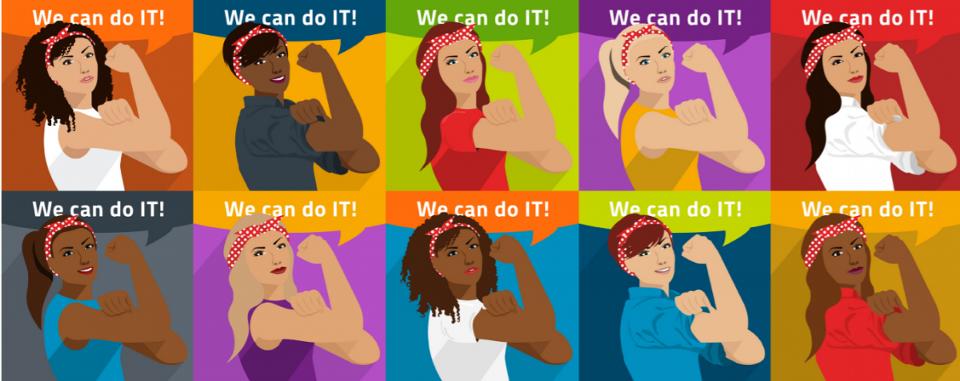
How To Get More African American Girls Into Tech by Ruchika Tulshyan
America will need to fill 1 million more STEM jobs than we will produce professionals in the next decade. And although we are among the world’s largest importers of technical talent, demand for these skills far exceed supply.
Yet it’s troubling how the industry continues to ignore women, a largely untapped resource in our own backyard. Especially women of color. Just a quarter of the over 5 million tech jobs last year were held by women, but the percentage of women of color – particularly black and Hispanic workers – in the industry stands at single digits, according to nonprofit Computing Technology Industry Association (CompTIA).
Tech companies have repeatedly blamed the education pipeline for gender and racial disparities. And in accordance with this narrative, tech organizations have invested large amounts to get more high school girls to pursue STEM degrees. In 2014, Google launched a $50 million plan to teach young girls to code. This year, President Obama proposed a new initiative calling for $4 billion in funding for states and $100 million directly for school districts to expand K-12 computer science education.
There’s only one problem with these solutions – exposure to computer science education alone doesn’t automatically result in more girls choosing a career in the field. In fact, girls who have taken a technology class are only 32% more likely to have considered a tech career. That’s according to a new study by CompTIA.
To change future ratios, it’s necessary for tech employers to actively recruit more women of color today. A role model currently working in technology is more likely to influence girls to consider a career in tech. Today, only 37% of girls surveyed by CompTIA reported knowing a family member or friend who worked in IT. But 60% of girls who had considered an IT career had a family member or friend working in the field. The gap is particularly stark for women of color, CompTIA president and CEO Todd Thibodeaux tells me. Women of color are the group least likely to have highly visible role models, he says.
Instead, hand-in-hand with developing a pipeline of qualified STEM graduates remains an urgent need for employers to recruit and retain more women of color, who can “communicate why they love working in tech” to girls of color, he adds.
The opportunity cost is huge – black girls reported being more interested in STEM subjects and careers than their white counterparts. More than double the number of African American girls surveyed by CompTIA said computer science was their favorite school subject (42% vs. 20% white respondents.) Half of the black respondents said math was their favorite school subject, compared with 34% of white girls. More importantly, 23% of black girls had considered a career in IT, compared with 19% of white girls . Of those who had considered it, 67% of African American girls vs. 40% of Caucasian girls responded that they were attracted to this career path because they understood how to use different technology. And more African American girls believed they had the skills to be good at an IT job – (50% vs 39% white.)
Despite the early interest, black girls and women are routinely excluded from lucrative tech careers.
Black women in technology have often pointed to the industry’s ambiguous hiring practices, including “culture fit,” as a reason for discrimination and exclusion. Even when employers make a vocal commitment to diversity, research shows that people of color are systematically screened out. Facebook recently blamed its lack of black employees to a scarcity of qualified candidates. African American men and women make up just 2% of the behemoth’s workforce.
Recruitment is part of the solution. “Employers need to look beyond traditional job boards and want ads to find a broader pool. An example might be getting engaged with a local community computer training program to find people who demonstrate interest and aptitude,” Thibodeaux says. Then, there’s retention; a sustained commitment to ensure employees of color receive support and training in the first six months of a hire. Ticking off a diversity box only to have women of color leave soon after – and share negative experiences – would be counterproductive. “We need to emphasize the team aspects and environment of the tech workplace.” Of course, without a healthy environment in the first place, it’s no wonder fewer girls consider a career in tech.
From a pipeline perspective, girls of color are also often misinformed about what is required to work in the field, according to CompTIA. “The most important thing we must communicate to this audience is working in tech, such as being a computer support specialist, does not require a STEM background,” he says.
Indeed, it’s easy for company leaders to justify their diversity numbers by pointing to a lack of interest or education among girls of color. But as this new research shows, education alone won’t solve the problem. It’s critical for employers to prioritize hiring more women of color today. It’s the only way to create the diverse pipeline of tomorrow.
Ruchika Tulshyan is the author of The Diversity Advantage: Fixing Gender Inequality In The Workplace (Forbes, 2015). Connect with her on Twitter.


Sorry, the comment form is closed at this time.